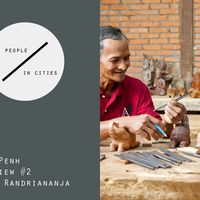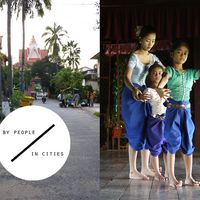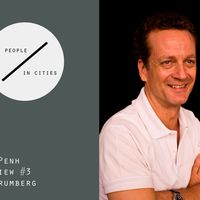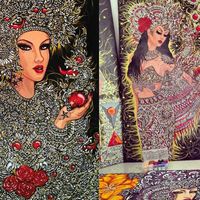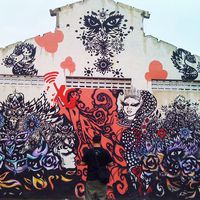By People / In Cities : Phnom Penh | interview with Maria Fernandez Sabau

The first interview for By People / In Cities: Phnom Penh invites Maria Fernandez Sabau to share her views on Cambodian art and culture. She is a culture expert currently working as an advisor to UNESCO on the development of cultural policies in Cambodia.
Q: If you had to pick one word to describe Phnom Penh, what would it be?
Re-construction
Q: How would you articulate the relationship between cultural heritage and new creative practices in Cambodia?
Cultural heritage is a source of inspiration for Cambodian artists as much as contemporary themes. Traditional elements of Cambodian culture are present in many of the current works. New creative practices in Cambodia are often looking for their roots and connection with the countries’ traditions, as one of the challenges of contemporary Cambodian artists is to find room for self expression in a country where almost every artistic form disappeared during the Khmer Rrouge period (1975-979). This void makes that the use of traditional forms and materials is often combined with contemporary themes in an interesting and unique exploration.
In addition, the magnificent cultural heritage of Cambodia and its contemporary practices have great potential in shaping the country as a complete cultural destination. Until recently it was mainly know for the Angkorian temples’ however, there is a new generation of young artists producing very interesting works in many disciplines: visual arts, dance, music, etc. The recent opening of new art galleries in Phnom Penh and Battambang, the recovery or traditional music forms and the emergence of different style of dance groups make Cambodia a great cultural destination for everyone interested in experiencing the past and present of the local arts.
Q: What would help improve the situation for artists and arts organizations in Phnom Penh?
Vision:
In Phnom Penh and the rest of the country there is a need for a long term vision of how strategically important culture and art are for such a culturally rich country as Cambodia.
The approval of cultural policy for Cambodia agreed and supported by the government and members of the arts sector will be key for the recognition of the contribution of culture and the arts in the development of the country. There are some efforts on their way, which should be speed up to help rebuild the arts sector. Also the creation of an arts alliance that would acts as a network of artists and private organisations would be fundamental to increase visibility of Cambodian arts nationally and internationally.
Recognition and support:
Public engagement is also required. As much as Cambodia is an artistic country by nature, the work of arts and artists is not always recognised. There is a need to connect art forms with the public in general and to attract the support of patrons in particular. There is an opportunity to connect the rapidly growing number of high wealthy individuals and corporations in Phnom Penh with the increasing number of local creators.
Q: Do the arts and culture have the capacity to bring social change in Phnom Penh? And are they accessible enough for local people?
The arts were and still are part of the Cambodian identity; they express daily realities and conflicts.
70% of Cambodian population if under 30 years old. Society is very traditional but is changing very fast due to the rural exodus to cities and the diverse presence of international personnel and aid workers, while young local people are looking for employment opportunities to increase their quality of life and that of their families.
In this context Phnom Penh is rapidly becoming a modern busy city where art and culture are displayed in western-stile facilities such as art galleries and theatres.
These places are still not obvious choices for local people. Artists and institutions still need to find formats and spaces that make new creative forms more accessible to larger local audiences.
In my opinion art and culture have the potential to bring social change by opening to new themes and realities as well as providing sustainable opportunities for artists. For that the art and cultural consumption needs to increase and become part of the regular habits.
Q: How do you envision the future for young artists in Phnom Penh?
Despite all the challenges mentioned I envision a enriching and exciting future for Cambodian arts and artists. Some years ago the younger generation of artists had been brave enough to initiate the process of revitalisation and reconstruction. As artists and professionals they are reaching maturity and progressively gaining recognition now. They have opened the path for the next artists groups to develop. Arts organisations have also evolved and adapted to this new reality. Organisations like Phare Ponleu Selepak are following artists through their careers, developing new contexts and activities. Also Seasons of Cambodia, led by Cambodian living arts, will bring 125 Cambodian artists as ambassadors of Cambodian art to perform and exhibit in New York in April – May 2013.
In my view all these are positive signs that the re-construction of the arts sector is underway and arts and culture have the potential to become Cambodia’s national signature in the years to come.
María Fernández Sabau is a cultural consultant that specialises in the management of cultural institutions through strategic planning, policy design as well as concept development for new centres and improvement of museum operations.
In 2000 she decided to pursue her true vocation managing cultural institutions and moved to London where she worked as a destination consultant and then joined Lord Cultural Resources. In 2005 she co-founded Lordcultura, the Spanish branch of the leading cultural consultancy group.
During the last ten years Maria has lead more than 30 projects worldwide developing her ability to understand culturally diverse group’s needs and agendas. She is a trusted advisor in the identification of priorities and recommendation of strategies by leading museums, governments and policy makers. Some of the institutions for whom she has provided advice are: the Museum Guggenheim Bilbao, Ministry of Culture of Spain, London Design Museum, TATE Gallery, Thailand Desing Centre, Singapore Ministry of Culture, the FitzWilliam Museum and the Great London Authority.
Maria participates as guest speaker in specialized conferences and University courses and contributes on a regular basis to professional publications on the topics of cultural policy, audience development, visitor profiles, marketing and communication. Her latest appearances were TEDxPhnom Penh speaking about creativity and the Chinese Museums Association Museum Leadership Seminar on the topic of ‘Museums, governments and governance’.
She is interested in creativity and innovation; social and intra-cultural change and the contribution of the cultural sector to the development of the knowledge economy.
Her concern about how the cultural sector can be a driver for development took her to Cambodia in 2011, where she is currently working as Expert Advisor for UNESCO in the development of the Cultural Policy for Cambodia.
By people / In cities is a series of articles and interviews that aims to enhance the understanding of art and culture in Southeast and East Asia through individual stories and perspectives including artists, cultural practitioners, and policy makers from the following 6 cities: Bangkok, Jogjakarta, Kuala Lumpur, Phnom Penh, Hong Kong and Singapore.
The second series introduces Phnom Penh, Cambodia, through its cultural heritage and the recent transformations that have been taking place at the intersection of traditional and contemporary practices.

